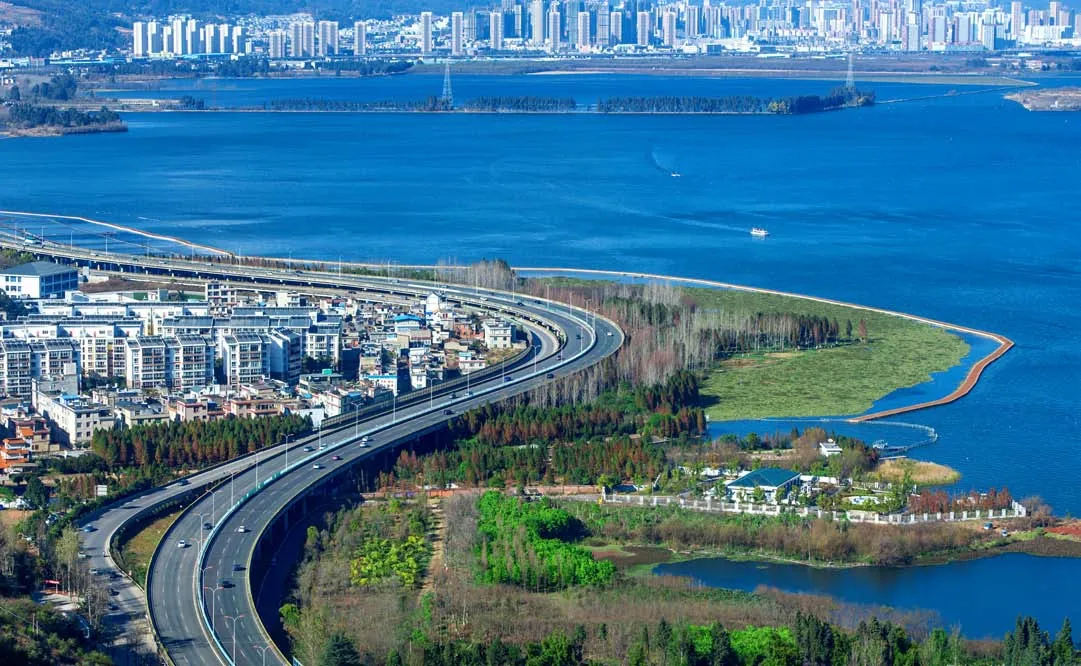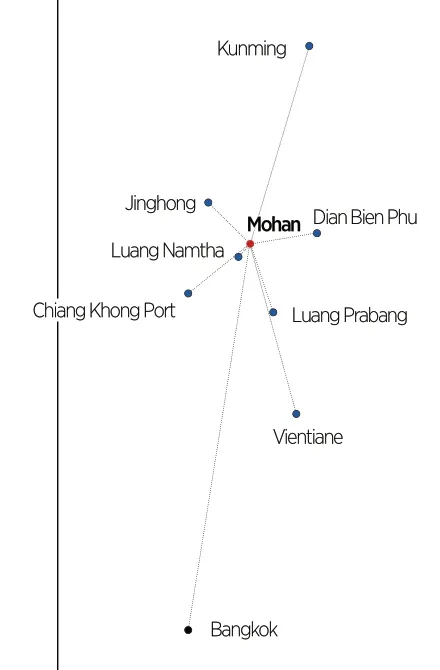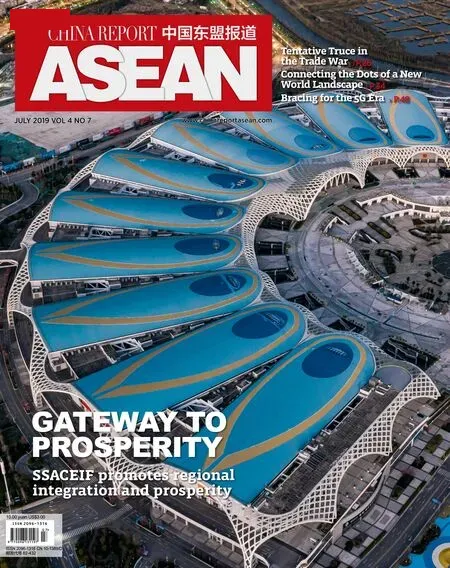THE YUNNAN ADVANTAGE
By Zhong Yunxuan
Yunnan Province is leveraging its geography to embrace wider opening-up
Poised at a crossroads between vastly different geographic regions, Yunnan is connected with the Silk Road Economic Belt in the north and the Maritime Silk Road in the south.
A s usual, Mohan Port on the border of China and Laos is open and ready at 8:30 a.m. Various vehicles queue up along Dongmeng Avenue for clearance including passenger buses labeled “Kunming[China]-Vientiane [Laos]” or “Kunming[China]-Houayxay [Laos].” At the same time, cargo begins quickly passing through Hekou Port as trains on metergauge railways chug along across the border. Everything runs in an orderly and efficient manner. Such scenes can also be seen in Qingshuihe National Port in Mengding Town of Gengma Dai and Va Autonomous County in Lincang City and Houqiao Port in Tengchong City. At border ports in Yunnan Province, shuttling lorries and trucks carry China's construction materials and daily necessities to South and Southeast Asian countries and return with bananas, pineapples, rubber, rice and other agricultural products.
During his visit to Yunnan Province in 2015, President Xi Jinping noted that Yunnan's advantage in economic development was its geographical location, which meant the key to prosperity was wider opening-up.This determination highlighted the province's distinct advantage and inspired a transformation of Yunnan from a peripheral locale to the forefront and pivot of China's opening-up.
A Pivot of China's Opening-up to South and Southeast Asia
About four years ago, at the construction site of Kunming South Railway Station in Kunming, capital of Yunnan Province, President Xi declared that Yunnan should be part of the grand landscape of national and world development. He maintained that Yunnan was required to proactively serve and integrate into the country's development strategy and build itself into a pivot of China's opening-up towards South and Southeast Asia.The prime advantage of Yunnan, as President Xi stated, is its geographical location.
Poised at a crossroads between vastly different geographic regions, Yunnan is connected with the Silk Road Economic Belt in the north and the Maritime Silk Road in the south. It is the only province of China that is linked to both South and Southeast Asia on land, and it reaches Europe and Africa through the Middle East. As a gateway to South, Southeast and West Asia, Yunnan touches not only Beibu Bay and the Bay of Bengal,but also the Pacific Ocean and the Atlantic Ocean. Such a distinct location makes Yunnan the intersection of the China-Indochina Peninsula Economic Corridor and the Bangladesh-China-India-Myanmar Economic Corridor.
A geographical advantage is crucial for border ports. Mohan Port is a good example. In Yunnan Province,Mohan is 181 kilometers from Jinghong and 700 kilometers from Kunming.Across the national border, Mohan is 62 kilometers from Luang Namtha,285 kilometers from Luang Prabang and 680 kilometers from Vientiane in Laos, 228 kilometers from Chiang Khong Port and 1,098 kilometers from Bangkok in Thailand. And it is further linked to Vietnam's Dian Bien Phu, 216 kilometers east of Oudomxay Province of Laos. Considering the geographical layout, the China-Laos Railway is expected to present a significant opportunity for Mohan to achieve leapfrog development. Once completed,the China-Laos Railway will become an integral part of the middle route of the Pan-Asia Railway Network and reduce the travel time from the border of China and Laos to Vientiane to less than three hours, making Mohan a possible hub for trade and economic cooperation between China and ASEAN countries.
Yunnan has made great strides in the development of infrastructure connectivity. The domestic section of the eastern route of the Pan-Asia Railway Network has begun operation,and construction of control structures for the western route has started.Construction has also been accelerated on the backbone railway network featuring eight routes stretching out of the province and five out of China,an expressway network and mainline network comprised of seven roads extending out of Yunnan and five out of the country and a water transport system featuring two waterways stretching out of Yunnan and three out of China. Relevant countries have been working together to build international transportation corridors including China-Vietnam, China-Laos-Thailand,China-Myanmar and Bangladesh-China-India-Myanmar corridors.The North-South Thoroughfare,Longrui (Longling-Ruili) Expressway,Kunming-Paris air route, and Kunming-Rotterdam and Kunming-Rhodes international freight trains are all now in operation. The Ruili Experimental Zone and its Made in Ruili program have gained great momentum, and Yunnan has been integrated with highvoltage power grids in Vietnam, Laos,Myanmar and other countries of the Greater Mekong Subregion. The China-Myanmar gas pipeline is complete and providing service.

An expressway along Dianchi Lake in Kunming, capital of Yunnan Province.

Mohan is 181 kilometers from Jinghong and 700 kilometers from Kunming.Across the national border,Mohan is 62 kilometers from Luang Namtha,285 kilometers from Luang Prabang and 680 kilometers from Vientiane in Laos, 228 kilometers from Chiang Khong Port and 1,098 kilometers from Bangkok in Thailand.And it is further linked to Vietnam's Dian Bien Phu,216 kilometers east of Oudomxay Province of Laos.

Since 2012, Yunnan's GDP annual growth rate has reached 9.4 percent, as the province's economy grew from 1.03 trillion yuan (US$0.15 trilion) in 2012 to 1.79 trillion yuan (US$0.26 trilion) in 2018.

Its GDP grew by 9.7 percent year-on-year in the first quarter of 2019. The province's year-on-year growth of total imports and exports in the first quarter was 13.4 percent, 9.7 points higher than the national level of 3.7 percent.
In recent years, Yunnan has been striving to become a hub radiating to South and Southeast Asia as it explores paths towards leapfrog development,making significant progress in promoting the Belt and Road Initiative through cooperation with South and Southeast Asian countries. Deepening reform through expanding openingup, Yunnan has already achieved impressive economic growth. Since 2012, Yunnan's GDP annual growth rate has reached 9.4 percent, as the province's economy grew from 1.03 trillion yuan (US$0.15 trilion) in 2012 to 1.79 trillion yuan (US$0.26 trilion) in 2018. Its GDP grew by 9.7 percent yearon-year in the first quarter of 2019. The province's year-on-year growth of total imports and exports in the first quarter was 13.4 percent, 9.7 points higher than the national level.
Zong Guoying, executive vice governor of Yunnan Province, said Yunnan would seize opportunities presented by the Belt and Road Initiative, continue its efforts to build and improve multilateral and bilateral cooperation mechanisms and strive to become a major contributor to the Lancang-Mekong Cooperation,the cooperation in Greater Mekong Subregion and Bangladesh-China-India-Myanmar cooperation. As a major participant of China in Lancang-Mekong Cooperation (LMC), Yunnan set up the LMC China Secretariat Liaison Office and launched the Bangladesh-China-India-Myanmar Forum for Regional Cooperation (BCIM).Yunnan has also successively hosted five China-South Asia Expos which targeted cooperation with South Asian countries, and participation has grown from 42 to 87 countries and regions. In 2018, Yunnan hosted the first China-South Asia Cooperation Forum, a new platform for dialogue, investment,communication and cooperation between China and South Asian countries.

Myanmar people living along the China-Myanmar border pass through Ruili Port in Dehong Dai and Jingpo Autonomous Prefecture, China's Yunnan Province, on December 11, 2018.
As the Belt and Road Initiative has made steady progress, Yunnan has been pushing for infrastructure connectivity to promote and integrate into the macro framework of China's opening-up strategy. According to Zong, the China-Vietnam, China-Laos and China (Ruili)-Myanmar highway sections in China are all now open to traffic. As for rails,the China-Vietnam railway sections in China are in service, construction of the entire line of China-Laos railway has started, and construction of the China-Myanmar railway sections in China is accelerating. Yunnan now hosts 81 global and regional airlines across the province, enabling the cargo and passenger airlines to connect it to capitals and major tourist destinations in South and Southeast Asia. The China-Myanmar oil and gas pipelines are in operation, and China is currently conducting regional trade of electricity with Vietnam, Laos and Myanmar through integrated power grids. From 2015 to 2018, the total trade volume of electricity worldwide reached 13 trillion kWh. Yunnan is the first province in China to enable the country's three major telecommunication operators to provide service for specific regions outside of China. Residents of eight of China's neighboring countries can enjoy Chinese international telecommunication services through Yunnan.
Border Momentum
Yunnan boasts 25 national ports including 19 category-1 ports. To speed up customs clearance, the province launched one-stop certification in its ports. The Yunnan Lincang Border Economic Cooperation Zone and Mengla (Mohan) Experimental Zone were approved by the government,the Honghe Free Trade Zone is now operating smoothly, and Kunming Free Trade Zone has passed preliminary inspection. Yunnan has become one of the few provinces confirmed by the National Development and Reform Commission to promote the provincial coordination mechanism of international cooperation in building industrial capacity.
Houqiao Port is an excellent example.The new checkpoint of Houqiao Port has greatly streamlined customs clearance and increased the traffic volume at the port. Small automobiles can pass the inspection in as short as a minute,and individuals can pass in three.From January to April in 2019, the total number of cars passing through Houqiao Port reached 89,000, up 16.89 percent year-on-year. The value of freight and volume of inbound and outbound trips measured US$209 million and 248,600 respectively, up 106 percent and 27.2 percent year-on-year. The statistics of Houqiao Port evidence that it is one of Yunnan's busiest land ports.
As connectivity and access foster industrial prosperity, unimpeded operation of border ports is reshaping the structure of Yunnan's economic development. Imports of agricultural products, jade and amber and exports of infrastructure materials and light industrial products have increased rapidly as relevant industrial clusters have gradually taken shape. For example, a massive jadeite and amber wholesale market has emerged in Tengchong County, Yunnan Province.The market integrates wholesale,manufacturing and retail businesses,employing around 30,000 including many carving masters and agents of branded jewelers. Tengchong's Jade and Amber Bazaar is organized every five days and attracts distributors from around the world. The market has helped Tengchong become known in China as both the City of Jade and the City of Amber.
Yunnan's cross-border RMB services now cover 83 countries and regions.From 2013 to June 2018, the total volume of cross-border RMB settlement transactions was 362.3 billion yuan through nine cross-border RMB flow systems. A single-window system for international trade is now connected with the border trade system, enabling cross-border RMB cash transfer between China and Laos. Yunnan is also involved in management of venues for border trade, and its border ports have introduced cutting-edge fingerprint scanners alongside various reforms of customs clearance including paperless clearance, self-service clearance and online declarations for tourist groups. Qualified enterprises and companies are encouraged to issue foreign debt, and the publication of the Ruili Index and the YD Index for RMBMMK exchange and RMB-VND exchange has opened up 24 convertible currencies. Yunnan also founded China's first Anti-Counterfeit Currency Center and reinforced its cross-border finance center and clearance and settlement center with support from financial institutions and enterprises.
“Our hometown now has more roads and houses, and local industries have grown,”said Feng Jiahao, member of the Party committee of Yingjiang County and director of the local publicity department. “The border areas have become more harmonious, and our lives are improving steadily.” According to Luo Hongyu, an administrator of Ruili Experimental Zone,the province's first self-service customs clearance system is in operation, and coordinated management of cross-border animal epidemic prevention and treatment is seeing steady progress in Ruili. The Nongdao route of Ruili Port has already been completed. Stakeholders are confident that Ruili will quickly rise to the forefront of China's opening-up.
Expanding Two-way Opening-up
Integration of internet services is also developing. China has achieved cross-border terrestrial cable connection with Myanmar,Laos and Thailand, through which the route length to Europe can be cut by nearly 10,000 kilometers and the delay time by at least 40 milliseconds.
According to Yu Wenlan, an associate research fellow of the South Asia Institute of Yunnan Academy of Social Sciences,Yunnan should leverage its geographical advantages and seize digital economic opportunities to accelerate development of Digital Yunnan.Ideal geography and emerging digital economics offer Yunnan powerful drivers to become a digital hub capable of radiating influence as far as South and Southeast Asia. Indeed,digitalization was precisely the highlight of the 2019 South and Southeast Asia Commodity Expo and Investment Fair. A booth there featuring Digital Yunnan and its 5G network presented several products for the digital economy including smartphone apps providing instant and accurate travel information,government advisories and agricultural information about Yunnan. The products aim to facilitate deep interaction between humans and data and make 5G part of daily life.The expo demonstrated that technologies improve life, and offered great digital experiences for visitors from South and Southeast Asian countries.
Through various platforms of opening-up, Yunnan has managed to break through the high mountains that once confined it. Tapping its potential in resources, ecology, geography and opening-up, Yunnan has been steadfastly pursuing deeper cooperation and communication through opening-up. So far,Yunnan has established bilateral cooperation mechanisms with countries including Thailand,Laos, Vietnam, Myanmar, India and Maldives and has become sister cities with 90 cities in 34 countries.

The Chinese believe that nations should respect others'interests while pursuing their own and advance common interests of all. Yunnan is committed to exploring and expanding its convergence of interests with neighboring countries. Many priority cooperation projects have produced promising early results such as the Saysettha Development Zone and Thaketa Power Plant, which were welcomed by locals.Economic and trade exchange between Yunnan and South and Southeast Asian countries has been expanding, and the province's total import and export volume reached US$29.89 billion in 2018, an increase of 24.7 percent, ranking second among provinces in western China. By 2018, Yunnan had established 788 enterprises and institutions in 58 countries and regions,with a total direct investment of over US$10 billion. In the fields of finance and technological innovation, Yunnan has been the vanguard of stimulating impetus for common development with neighboring countries. Yunnan was one of the first pilots for cross-border RMB transactions with personal currency accounts,and its businesses now serve 43 countries and regions. Fudian Bank of Yunnan Province and BCEL, a Laos-based bank, came together to establish Lao-China Bank, a trendsetting joint venture among commercial banks reaching out across borders.
As President Xi stressed, the Belt and Road Initiative needs not only high-level plans but also intensive and meticulous implementation. On the grand blueprint of the initiative,people-to-people bonds have been critical. Yunnan is geographically close to South and Southeast Asian countries,which has promoted exchange in technology, culture, public health and medical services and made ties between people across the region even closer.

